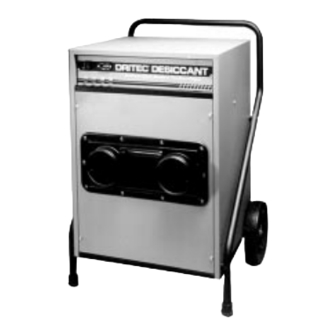- ページ 4
除湿機 Dri-Eaz DRITEC 325のPDF オーナーズマニュアルをオンラインで閲覧またはダウンロードできます。Dri-Eaz DRITEC 325 11 ページ。 Desiccant dehumidifiers
Dri-Eaz DRITEC 325 にも: オーナーズマニュアル (11 ページ)

When in use, the DriTec Dehumidifier draws in air from
a room through the air inlet. This air passes through the hon-
eycomb channels of the rotor. As this happens, the desiccant
material captures most of the moisture present in the air.
Once this "process air" has been dried out, it is vented back
into the room.
As the rotor captures water vapor from the air, it be-
comes saturated with water. The saturated rotor eventually
loses its ability to capture additional moisture. The process
of removing this water from the rotor is called
"reactivation."
DriTec 325 shown (dual air outlets)
Reactivation Air
During operation, a portion of the rotor is constantly be-
ing dried or "reactivated." In the DriTec, heated air is di-
rected to the reactivation sector and is forced through the
channels in that portion of the rotor. The heated air releases
the moisture captured in the desiccant material. The moisture
is discharged into the heated "reactivation air stream" and is
then vented from the unit to the outdoors. As the DriTec
operates, the rotor slowly turns so that only a portion of the
whole rotor is exposed to the heated reactivation air at any
one time.
At this point, the moisture has been removed from the
room, stored on the rotor, and then released from the rotor
into the outside air. The desiccant dehumidification process
cycle is complete.
Here is a quick review of the operation:
1. Moist process air is drawn into inlet and through the de-
humidifier.
2. Moisture in the process air is captured on the desiccant
rotor and the dry process air is vented through process
outlets back into the room.
3. Reactivation air is heated within the dehumidifier.
4. The wet area of the rotor turns into the reactivation sec-
tor.
5. The moisture in the desiccant rotor is released into the
heated reactivation air.
COPYRIGHT © 1999 2000 DRI EAZ PRODUCTS INC
6. The reactivation air, laden with moisture, is vented
through the reactivation outlet to the outdoors.
7. The reactivated rotor rotates into position to capture
more moisture.
OPERATING CONDITIONS
The DriTec Desiccant Dehumidifier effectively removes
moisture at virtually any job temperature without the freeze-
up problems associated with refrigerant dehumidifiers. Low-
temperature operation is one advantage of using desiccant
technology.
The DriTec dramatically reduces ambient humidity to
very low levels not obtainable with refrigerant dehumidifi-
ers. This allows faster and more thorough drying of dense
materials like hardwood flooring and structural woods.
The DriTec also uses improved technology that removes
humidity When a desiccant dehumidifier is first put into
operation in a saturated environment, it will constantly re-
duce humidity. Its rate of water removal is determined by the
volume of the area, the environmental conditions, and the
capabilities of the machine.
Saturated Environments
On many restorative drying jobs, the initial humidity is
very high as porous materials like carpet and cushion give
up moisture to the air. However, as the job progresses and
humidity levels fall, moisture may need to be evaporated
from less porous materials including drywall and wood.
Refrigerants are most effective when both humidity and
temperature are high. They are much less effective in ambi-
ent conditions under 50% relative humidity or 50°F (10°C).
Desiccant dehumidifiers are generally effective in all ranges
of temperature and humidity.
In saturated environments it is often helpful to use the
DriTec Desiccant together with refrigerant units to speed the
drying process. In these conditions the DriTec removes wa-
ter as well as a comparable refrigerant unit. Also, it is actu-
ally more cost effective. (For example, a 25-gallon/day
refrigerant dehumidifier that costs $2,195 removes water at
$87.80 per gallon. The 48-gallon/day DriTec 325 that costs
$3,699 is removing water at $77.06 – a cost savings of over
$10/gallon.)
Lower Levels of Humidity
When the relative humidity falls to 40%, a refrigerant
dehumidifier will remove little additional water. At this
point many materials in the room such as carpets and wall
surfaces may feel dry, but moisture may remain in structural
materials. Ceilings, walls, and structural flooring materials
typically take longer to dry. The DriTec Desiccant is supe-
rior for drying these materials. It has the capability to lower
humidity over time to below 1% Rh. The low humidity envi-
ronment created by the DriTec speeds the drying of struc-
tural materials which dry very slowly in conditions of
normal, comfortable humidity.
The DriTec Desiccant also can be more cost-effective
than refrigerant dehumidifiers in low-temperature condi-
tions. The DriTec continues to remove moisture at tempera-
4
